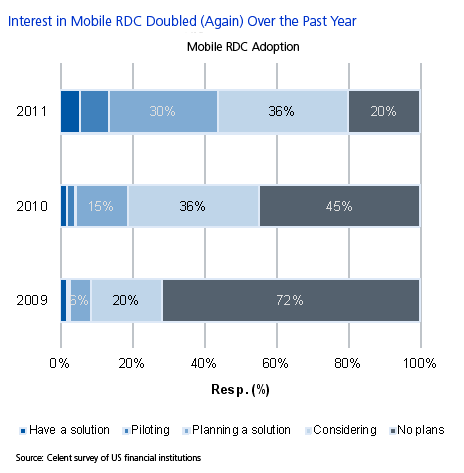Growth in self-service channel preferences, competitive pressures, and relentless cost reduction demands are vaulting RDC into the consumer mainstream. Mobile RDC is taking center stage, with 80% of surveyed financial institutions planning or considering a solution.
Until recently, remote deposit capture (RDC) has been limited to business clients. The past few years have seen several hundred financial institutions, mostly credit unions, offer consumer capture using devices consumers already own, thus eliminating the cost of providing and supporting scanners. RDC thus becomes a viable self-service deposit channel; that is, for consumers with a scanner, a demographic that excludes most US households. More popular still is mobile RDC. Mobile RDC invites the use of smartphones, running a stand-alone application or as part of a broader mobile banking solution. Both mechanisms will soon be broadly offered by financial institutions and widely used by consumers.
According to a new report featuring results of a Celent survey, The State of Consumer RDC 2011: Mobile Takes Center Stage, the number of US financial institutions planning to offer mobile RDC has doubled over the past year. Celent expects interest in mobile RDC to continue to grow because banks face a challenging revenue outlook and mounting cost pressures in the retail channel, a situation worsened by the Durbin Amendment to the Dodd-Frank Financial Reform and Consumer Protection Act, which took effect in October 2011.

“The real challenge with self-service deposits may be the transformation required as transactions move out of the branch,” says Bob Meara, Senior Analyst with Celent’s Banking group and author of the report.
“Self-service deposits are at odds with the pervasive cross-selling culture at most banks. Reduced branch traffic presents a sales challenge, but deposit-related foot traffic comes at a significant cost—one that US banks may no longer be able to afford,” he adds. “Mobile RDC may be the best idea yet to hasten the branch transformation we all know to be inevitable.”
Leveraging self-service channels is an established strategy, but not in the realm of check deposits. With consumer RDC, financial institutions have a means to dramatically reduce transactional activity in their branch networks. In addition to looking at adoption motives and barriers, this report reviews RDC risk and compliance options, the consumer RDC solution provider landscape, and surveys market opportunity for mobile RDC in the mass market, wealth management, and small business market segments. This report draws from a July survey of 12 solution providers and a September online survey that drew responses from 218 financial institutions.





